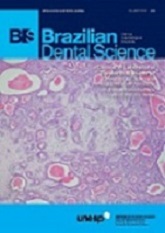Effect of different light-curing techniques on hardness of a microhybrid dental composite resin
DOI:
https://doi.org/10.14295/bds.2014.v17i1.950Resumo
Objective: This study assessed the Vickers hardness provided by two LCUs when using (1) direct and indirect light-curing techniques, (2) 40 and 60 seconds and (3) top and bottom surfaces. Material and Methods: One halogen Curing Light 2500 (3M Espe) and one LED (MM Optics) were used by direct and indirect (0, 1.0, 2.0 and 3.0 mm of dental structure) techniques during 40 and 60 seconds. The samples were made with FiltekTM Z250 in a metallic mould with a central orifice (4 mm in diameter, 2 mm in thickness). The samples were stored in dry mean by ± 24 hours and the hardness measurements were performed in a testing machine (Buehler MMT-3 digital microhardness tester Lake Bluff, Illinois USA). A 50 gf load was used and the indenter with a dwell time of 30 seconds. The data were submitted to multiple ANOVA and Newman-Keuls‘s test (p<0.05). Results: Halogen LCU exhibited higher Vickers hardness values than LED mainly because of the power density used. Hardness values were influenced by LCUs, light-curing techniques, irradiation times and surfaces. For both LCUs, hardness values were found to decrease with indirect light-curing technique, mainly for the bottom surface. Samples irradiated for 60 s exhibited higher hardness values when the halogen LCU was used. For 60 seconds, the VHN values were statistically significant greater than 40 seconds. Significant differences in top and bottom surfaces Vickers hardness number (VHN) values were observed among different LCUs used 40 and 60 seconds. Conclusion: The LCUs, light-curing techniques, variations of irradiation times, and surfaces (top and bottom) influence the composite hardness.
Keywords: Composite resin, LED, Halogen lamp, Hardness, Photo-activation.
Downloads
Downloads
Arquivos adicionais
Publicado
Como Citar
Edição
Seção
Licença
TRANSFERÊNCIA DE DIREITOS AUTORAIS E DECLARAÇÃO DE RESPONSABILIDADE
Toda a propriedade de direitos autorais do artigo "____________________________________________________________________" é transferido do autor(es) para a CIÊNCIA ODONTOLÓGICA BRASILEIRA, no caso do trabalho ser publicado. O artigo não foi publicado em outro lugar e não foi submetido simultaneamente para publicação em outra revista.
Vimos por meio deste, atestar que trabalho é original e não apresenta dados manipulados, fraude ou plágio. Fizemos contribuição científica significativa para o estudo e estamos cientes dos dados apresentados e de acordo com a versão final do artigo. Assumimos total responsabilidade pelos aspectos éticos do estudo.
Este texto deve ser impresso e assinado por todos os autores. A versão digitalizada deverá ser apresentada como arquivo suplementar durante o processo de submissão.




























